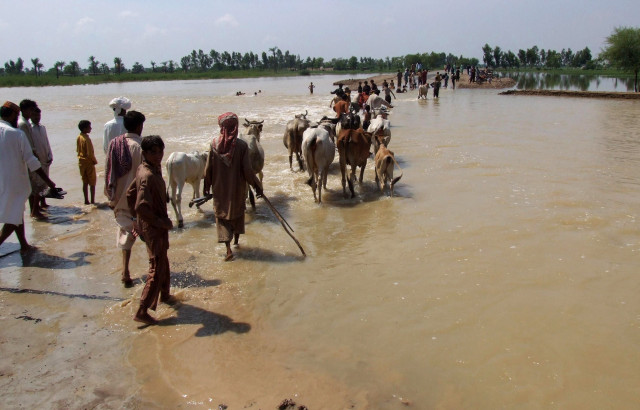Flood 12: Around 11% of Sindh’s crops destroyed
Farms in Jacobabad and Kashmore were some of the worst-hit.

Like a giant, watery scythe, torrents from Balochistan slashed crops in flood-hit areas of Sindh, leaving large gashes in growers’ wallets.
The farmers were initially exhilarated when the first few drops of water descended from the sky, hoping that the pests attacking their crops would be driven away. But now, as crops stand swathed in water, smiles have turned into frowns. The water gushing from hilly areas of the neighbouring province eroded the terrain as it swept into Sindh, picking up silt and small rocks which were subsequently peppered on the crops.
According to a survey by the agriculture extension department, three main kharif (autumn) crops - paddy, sugarcane and cotton - were planted on around 1.5 million hectares in Sindh. About 11 per cent of them have been completely destroyed and about seven per cent partially damaged by the recent downpour. Most of the crops planted in lower parts of the province have been spared. The growers in upper Sindh, however, were not so lucky. The crops in Kashmore and Jacobabad have been worst-hit by the rainwater.
Cotton was sown in 584,558 hectares throughout Sindh, out of which 12 per cent was completely destroyed and nine per cent partially damaged. Paddy was sown in over 678,142 hectares. The rainwater completely destroyed about 12 per cent of the crops and around nine per cent was partially damaged. Sugarcane was sown in over 271,085 hectares, out of which two per cent was completely destroyed and the same amount was partially damaged.
The agriculture extension department’s director, Riaz Ahmed Dayo, told The Express Tribune that cotton crops are extremely sensitive and have been ruined by the onslaught of muddy water. The crops’ buds are soggy and coated with a film of black grime, which has rendered them useless. The director said that the paddy and sugarcane crops, which are hardier, can still be salvaged. If stagnant rainwater is drained from the fields where the two crops have been planted, some of the growers’ losses can be cut.
Though the rainwater has yet to be drained, the government has already announced that it will provide seeds, fertilizers and other raw material to growers, who will also be exempted from the revenue tax.
Published in The Express Tribune, September 20th, 2012.



















COMMENTS
Comments are moderated and generally will be posted if they are on-topic and not abusive.
For more information, please see our Comments FAQ